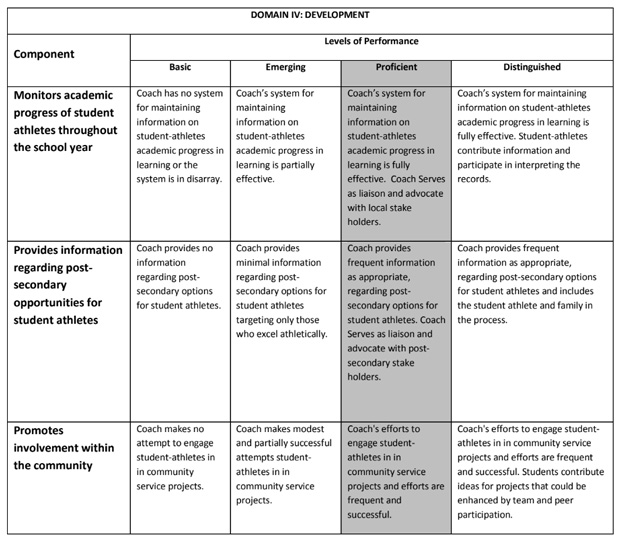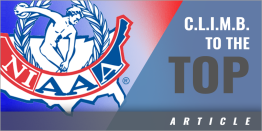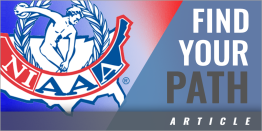| Leveraging Athletics to Improve Student Performance |
|
By: Joe Piro - Athletic Director, Nutley High School (NJ) I am the Director of Athletics for the Nutley School District and at NHS almost two-thirds of our student population participates in interscholastic athletics. We believe that because athletes represent the largest group within our student population, it is imperative that we leverage athletics to improve student performance in the hopes that their success will encourage, motivate and stimulate the rest of the student population to do the same. A program such as this is a collaborative effort that incorporates and requires "buy-in and participation" from all of our district shareholders. The shareholders include, but are not limited to, our community, parents, teachers, building and central office administrators, and most importantly, our coaches and student athletes. We have developed a program that is driven by our district mission statement and focuses on the development of the entire student athlete, from their performance on the field, to their performance in the classroom and their involvement in both the school and local community. We believe that by focusing on the entire student athlete we can not only improve student performance but also, "challenge, inspire, and empower students to become creative, confident, passionate, self-directed citizens who actively and purposely contribute in our global society." In order to grasp a strong hold on this concept, it is best to picture it as a pyramid that begins with a strong foundation and ends at a peak that will allow our student athlete’s reach to exceed their grasp. Our foundation begins with the coaches and the student athletes themselves. We have developed and executed several coaching effectiveness programs and professional development opportunities to enable our coaches to strengthen and expand their knowledge, ability and efficiency. These programs are centered on health and safety, mandatory certifications, efficiency, communication, evaluation and technology. We have found that the more we work on these components, the better informed and educated our shareholders are, thus the more efficient we become as a staff and department. We have also found that by working on these elements, we increase our knowledge of our student athletes in regards to their academic performance, attendance, discipline, community service hours and extra-curricular involvement. Having the ability, desire, and commitment to working with our student athletes this closely creates a watchful eye, enables us to be proactive to any predictable issues rather than reactive to incident, and sends a clear message to our district staff that we are committed to the development of the student athlete. It is our hope that this commitment will metastasize throughout the building and district and create a unified philosophy that runs parallel with our district’s mission and benefits our entire student population. THE COACHES ACADEMY Our plan began in the Summer of 2013 with a coaches academy that focused on the elements I previously discussed and will highlight in the next few pages. The Coaches Academy was a three-day workshop that was designed to educate and inform our district coaches in several different topics that we felt were necessary for their continued success. It also created a "think tank" by allowing our coaches to utilize each other’s knowledge to help increase their performance, as well as provided valuable information to me, the department leader, on areas that we can improve and grow. During the academy, coaches were able to satisfy their First Aid/CPR requirements, HIB requirements, and Concussion and Heat Acclimatization Certifications. They were also able to listen to qualified speakers on topics such as, our district’s strategic plan, the department’s goals, tips for being a better assistant coach, teaching captains how to lead, using a framework in the coaching and evaluation process, the college recruiting process, and managing student athletes through our school manager program. Coaches were asked to work in groups, speak in open forums, and create solutions to different case studies and common problems that they can or have been faced with during the course of their careers. The program was a true workshop that enabled each coach to collaborate, share and learn from each other, proving that steel truly sharpens steel. Due to the nature of athletics and athletic coaches, getting a group of people to buy into a plan that would not only help their athlete’s success but hopefully increase team success was not a difficult sell. In fact, it was easier to sell a group of 60 coaches on the ideas and theology of this program then it was to sell 300 teachers. You may ask why? The answer is simple…in order to be a successful coach, you must be able to see the entire picture. Good coaches, successful coaches, have the ability to watch the entire movie not just the snap shots. The idea of leveraging athletics to improve student performance is a big picture idea. In my experience as a player, coach, and now athletic administrator, I have found that only those who can see the big picture enjoy long term success with benefits that stretch far past the courts and fields. Small picture people, tunnel vision coaches, have some success; in fact they may win a championship or two, however, their inability to see the entire playing field will eventually be the reason for their failures. When you look at some of your most successful coaches, they have managed to build winning programs, with high graduation rates, and their athletes have experienced and shared great successes long after their playing time has run out. This is the backbone of leveraging athletics to increase performance. EVALUATION FRAMEWORK It is imperative that the athletic department mission, vision and plan run parallel with the district plan. From the framework, to the technology, to the language, everything has to be parallel. It is important that athletes hear the same terminology on the courts that they hear in the classroom. Frameworks and rubrics are not just tools used to evaluate academic projects. They are valuable tools for creating expectations among players and coaches. Below I have provided a small portion of our coaching framework that we use in our evaluation process. This framework has been designed to mirror that of our teacher’s framework. Of course we changed the terminology to suit athletics but I was shocked on how little we had to change.  There are five (5) domains in our framework. In this sample, (Domain IV – Development), we ask three things - are our coaches proficient in the following:
It is my hope that our coaches always fall into the proficient or distinguished columns, as it is our superintendent’s hope that our teachers fall into the proficient or distinguished columns. However, what is most important and what I find to be most telling, is what our coaches are doing to fall into those categories. If in fact they are proficient, what is their plan to become distinguished? This framework is not designed to trip up a struggling coach or be used as a tool to run out a coach who may not play the booster club president’s son or daughter. This framework is a blue print designed to continually challenge our staff, and serve as a reminder as to what our focus and charge must be -the development of our student athletes! MONITORING ACADEMICS An additional component that we feel is important is our coaches’ access to our student management software. We used our academy to educate and train our staff on the proper ways to use the system and have given them the resources to use it efficiently. This program allows each coach to create a group within our system and monitor that group as he or she would monitor their classroom. For instance, our football coach is able to view daily attendance records of his players, keep track of progress and discipline reports, review grades, track community service hours and be notified when there are any potential eligibility problems. Due to the large participation numbers in football, our head coach assigns a specific number of student athletes to each position coach. This not only involves his entire staff in the process but it also sends a clear message to the entire staff and team of just how committed we are to their academic success. An important component to this plan, perhaps the most important component, is communication. Communication technology such as email, text messaging, and social media has the information super highway moving at an intense speed and we cannot afford to slow down. Where most districts and staffs are talking about the negatives of social media and the perils of Facebook and Twitter, our district is embracing these outlets. We included a segment within our academy that talks directly to using these outlets as a tool to positively promote our program, share information vital to the day to day operation of our programs, and spotlight the good things that happen within our programs every day. Coaches review different ways to use these outlets to their advantage and discussed the importance of using positive, proactive communication with athletes and parents as a tool for success. COMMUNITY SERVICE It is mandatory in the Nutley High School Athletic Department that every sport team participates in a community service project. It is one of our most successful and rewarding programs. Our athletes have raised and donated thousands of dollars to benefit cancer research, The National Kidney Foundation, and organ donor awareness. They have cleaned local parks and river banks, worked with various special children’s groups, volunteered with our youth sports programs, shoveled snow and raked leaves for senior citizens, and have performed numerous acts of kindness in and out of our school community. This program works alongside our mission statement and inspires our student athletes to actively and purposely contribute. This program, along with the strides and efforts we make in the academic arena, sends a clear message to our shareholders that student athletes in NHS are held to a higher standard, follow the expectations laid out for them, and are committed to a standard that stretches way beyond the athletic fields and arenas. It is an integral part of our plan to view the big picture and accomplish big picture goals. CONCLUSION Due to the changes in education, particularly in the state of New Jersey, our district has gone through a renaissance. New evaluation and tenure guidelines, and a substantial change in administration, have caused some skepticism among our shareholders. Fortunately, coaches, staff and administration in my department have embraced these changes and created a new energy and enthusiasm and have channeled it in a positive direction. We have been able to take a forward-thinking approach, cultivate resources that were never made available to use, create venues to hone the skills that we use every day, and take a proactive approach to new policies and procedures. This has enabled us to work within a cutting edge strategic plan that follows our district course. However, this is not a, "one and done plan." The most important piece to this puzzle is our vision. It is imperative that coaches, administrators, and stakeholders continue to have the conversations that focus on forward movement and development. It is necessary that we continue to move forward, be crazy enough to think differently, bold enough to believe it and committed enough to carry it to fruition. Continuing to take a proactive, student driven approach to our interactions with student athletes will enable us to leverage athletics to enhance student performance. If done properly, we will help our student athletes accomplish their goals and our mission. Most importantly, the efforts and successes of our student athletes will motivate their peers to do the same, creating success throughout our district that is in line with our strategic plan and the backbone of our mission. For copies of any documents mentioned in this article contact the author (see below): Joe Piro, Athletic Director |








